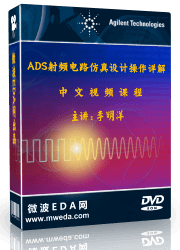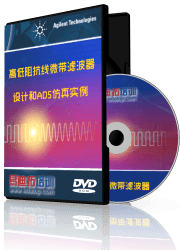- 易迪拓培训,专注于微波、射频、天线设计工程师的培养
How to check the model of varactor diode in ADS
I am trying to create model of SMV1247 - SC79 varactor diode in ADS, but I do not know whether the model that I create is correct or wrong. So, I think I must know how to measure parameters of model in ADS before, and I am trying to do it with BBY51-SOT23 varactor diode model that is a element of HFDiode_vendor_kit that is supplied by ADS (http://www.eas.uccs.edu/~mwickert/ec...DS_Library.pdf). I have read datasheet of BBY51, and I just see the curve describing the relationship between Capacitance and Reverse Voltage.
Could you show me how to measure the model of BBY51-SOT23 in ADS in order to ensure that this model is corresponding to BBY51 described in datasheet?
Thanks in advance.
Dear KisuLom,
For check the varactor's model in ADS, you need to do a S-Parameters simulation. Do this: On S-Parameters config adjust your frequency range and on Parameters tab, select Y-parameters. On your terminal, put on "VDC" parameter one variable. So put one "Parameter Sweep" box and put the VDC variable, e.g. "vdc", to be swept. On tab Simulations, set SP1 on Simulation 1 box. Then run your simulation.
On your Data Display Window, put the following equations:
1) Y11imag=imag(Y(1,1))
2) Y11imag_deriv=diff(Y11imag)
3) C = Y11imag_deriv/2/pi
Then plot your capacitance vs. vdc: plot_vs(C[::,0], vdc)
Where:
:: = all frequencies
0 = correspond to step-size of VDC variable. Example: 0 to 5V with 21 step-size (0.25V of step-size). Then this one will range from 0 to 20.
I made this process on another varactor (SMV1237) and the results are okay.
Best regards,
Eduardo.
Hi Eduardo, thanks for your help. I follow your way, but results are not what I desired. I noticed that the characteristic of BBY-51 is changed when I choose the diffirent ranges of frequency. Fig1 is corresponding to frequency range from 1.0GHz to 2.0GHz. Fig2 is corresponding to frequency range from 2.0GHz to 2.8GHz. Could you help me check my simulation [Fig.3] and try changing frequency ranges in your simulation in order to see whether characteristics of your SMV1237 model is changed according to ranges of frequency.
Thank you so much.



Hi,
Try to connect the other diode on the Gnd too. I think that if you leave disconnected maybe it causes problems.
The fact of capacitance changes according to frequency range is correct. But the results of second range (2.0Ghz to 2.8Ghz) is very strange. Try to put the same configurations as it is showing in datasheet (http://www.mouser.com/ds/2/196/bby51series-89159.pdf). At page 3, one graphic shows the capacitance (Ct) vs. voltage (Vr) at 1Mhz. For validate your design you need to obtain the same result.
Regards,
Edurdo.
Hi again,


Look my two graphics (They were designed on Cadence Virtuoso, but the equations were same). The first one has an exponential decay and with the frequency increase at the initial range of VDC (around 0 to 2V) the capacitance changes, varying from around 100pF to 500pF. In my case, this is correct. The frequency range was from 0 to 300MHz.
The second one has an error. Its similar to your when your frequency range was among 2GHz to 2.8Ghz. In the fact, I think that its occurs because the numerical derivative. In my case, the frequency range was from 0 to 1GHz.
Regards,
Eduardo.
申明:网友回复良莠不齐,仅供参考。如需专业帮助,请学习易迪拓培训专家讲授的ADS视频培训课程。
上一篇:How to use ADS to get I-V characteristics of MOSFET
下一篇:Order in Keysight ADS HB Simulatio.
ADS婵炴垶鎼╅崢浠嬪几閸愵亝鍠嗛柛鈩冧緱閺嗐儵鏌涢埡鍐炬敯妞ゆ柨瀚板顐⑩枎閹存梹鐓� | More...
 国内最全面、最专业的Agilent ADS培训课程,可以帮助您从零开始,全面系统学习ADS设计应用【More..】
国内最全面、最专业的Agilent ADS培训课程,可以帮助您从零开始,全面系统学习ADS设计应用【More..】
- Agilent ADS教学培训课程套装
- 两周学会ADS2011、ADS2013视频教程
- ADS2012、ADS2013射频电路设计详解
- ADS高低阻抗线微带滤波器设计培训教程
- ADS混频器仿真分析实例视频培训课程
- ADS Momentum电磁仿真设计视频课程
- ADS射频电路与通信系统设计高级培训
- ADS Layout和电磁仿真设计培训视频
- ADS Workspace and Simulators Training Course
- ADS Circuit Simulation Training Course
- ADS Layout and EM Simulation Training Course
- Agilent ADS 内部原版培训教材合集








